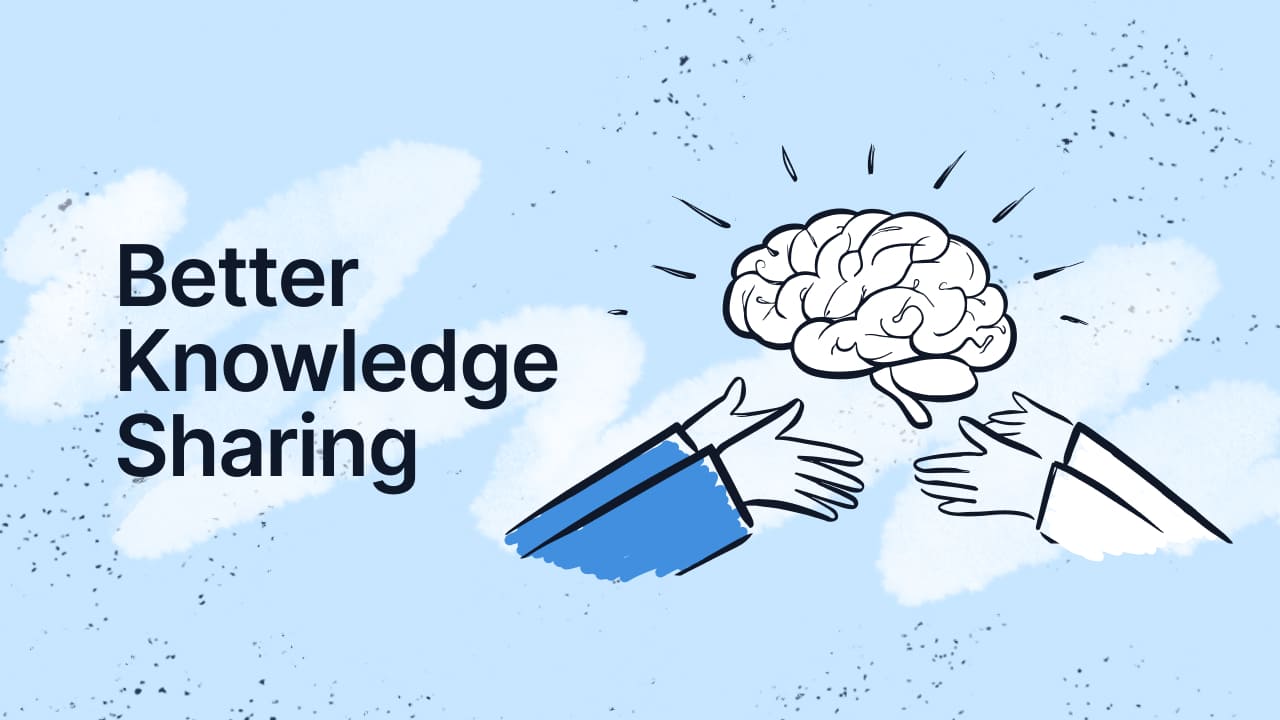Knowledge is a vital asset for Service Management. But not all knowledge is created equal. In ITIL, knowledge comes in different forms, and understanding these various knowledge types is essential, as each one presents its own set of challenges when it comes to effectively sharing, utilizing, and transferring this valuable information.
The good news is that leaders can develop strategies to ensure this information is leveraged to its fullest potential. After all, a one-size-fits-all approach simply doesn't work when it comes to something as multifaceted as organizational knowledge.
To help you with this, we'll explore the different knowledge types and provide practical advice on managing them effectively.
Let's start!

The different knowledge types
In ITIL, Knowledge Management is more than just information stored in documents or databases. It’s the actionable insights and expertise that help organizations make informed decisions, solve problems, and deliver high-quality IT services.
ITIL Knowledge encompasses everything from detailed procedures and best practices to the more abstract skills and experiences that staff accumulate over time.
Categorizing knowledge into different types is critical for effective management because it allows organizations to apply the right methods for capturing, sharing, and using this knowledge.
By understanding the nature of different knowledge types, IT teams can ensure that important insights are not lost and are accessible when needed, whether through formal documentation or more informal means like discussions and mentorship.

Explicit knowledge
Explicit knowledge represents the most accessible and structured form of knowledge within an organization. It is easily documented, shared, and articulated, making it a fundamental component of ITIL’s Knowledge Management.
Formal documents typically capture explicit knowledge, which provides clear, step-by-step instructions and guidelines.
Because of its structured nature, explicit knowledge is crucial for ensuring consistency across IT Service Management practices. It allows teams to rely on standardized information that can be easily referenced and communicated.
Characteristics
- Can be easily written down and transferred: Explicit knowledge is straightforward to capture and communicate, whether in writing, diagrams, or other formats.
- Structured and organized for easy access: This type of knowledge is typically well-organized and often stored in databases, manuals, or other formal documentation.
Examples of this knowledge type
- Service Level Agreements (SLAs): SLAs are documented agreements that outline the expected level of service between providers and customers, providing a clear and accessible reference.
- Knowledge base articles and documentation: These resources offer step-by-step instructions, troubleshooting guides, and other information that IT staff can easily refer to when needed.
- Standard Operating Procedures (SOPs): Detailed instructions that describe the regular tasks and processes that must be followed to ensure consistent service delivery.
- Compliance documentation: Official records that outline how an organization adheres to regulatory standards, industry norms, or internal policies.

Implicit knowledge
Implicit knowledge, while not as formally structured as explicit knowledge, plays a vital role in ITIL’s knowledge management. This type of knowledge isn’t typically documented but is understood through regular practice and observation.
It is often embedded in organizational processes, workflows, and the unwritten rules that guide how tasks are performed. Unlike explicit knowledge, which is readily accessible, implicit knowledge requires engagement with the work environment to be fully grasped.
Through activities like shadowing, participation in meetings, and collaboration with colleagues, individuals absorb implicit knowledge that influences how explicit knowledge is applied in real-world scenarios.
Characteristics
- Often embedded in processes and workflows: Implicit knowledge is ingrained in the routines and habits of an organization, and it influences how tasks are completed, even if they aren’t explicitly outlined.
- Can be inferred through observation and participation: Team members often pick up implicit knowledge by working alongside more experienced colleagues and observing how things are done.
Examples of this knowledge type
- Organizational culture and norms: The unwritten rules and values that guide how IT staff interact and make decisions within the organization.
- Best practices: Established methods or techniques that are recognized as more effective than others but may not be formally documented.
- Decision-making patterns in team meetings: The habitual ways in which decisions are made within teams, often influenced by group dynamics and past experiences.
- Usage of tools beyond documented use cases: Practical knowledge of how to effectively use tools and software in ways not explicitly covered in manuals or official documentation.

Tacit knowledge
Finally, tacit knowledge is the most personal and elusive type of knowledge within ITIL’s knowledge management framework. It is deeply rooted in individual experience, often acquired over years of practice and interaction with complex systems and processes.
Unlike explicit or implicit knowledge, tacit knowledge is challenging to articulate or document because it is inherently context-specific and resides within individuals.
This type of knowledge is often revealed through problem-solving, intuitive decision-making, and the understanding that comes with experience. To harness tacit knowledge effectively, organizations must focus on fostering environments where knowledge can be shared, for example, through mentorship and direct collaboration.
Characteristics
- Gained through experience and practice: Tacit knowledge develops over time as individuals engage in tasks, learn from mistakes, and refine their skills.
- Often resides in individuals rather than documents: This type of knowledge is usually held by seasoned IT staff who have developed unique approaches to problem-solving and decision-making.
Examples of this knowledge type
- The expertise of seasoned IT staff: Long-time employees often possess a deep understanding of systems, processes, and the nuances of the organization that newcomers might lack.
- Problem-solving techniques developed over time: Methods honed through years of dealing with recurring issues or complex challenges.
- Understanding of legacy systems and their quirks: The specialized knowledge of older systems that have been in use for years, including how to maintain and troubleshoot them effectively despite outdated documentation.
- Expert troubleshooting techniques: The intuitive methods and approaches developed by experienced IT professionals to quickly identify and resolve complex technical issues.
The interrelationship between different knowledge types
These three knowledge types—explicit, implicit, and tacit—are deeply interconnected within ITIL’s Knowledge Management framework. Explicit knowledge provides the formal foundation upon which organizations can build standardized processes, ensuring that critical information is accessible to all.
Although not formally documented, implicit knowledge often guides how explicit knowledge is applied in practice, embedding organizational culture and norms into daily operations.
Tacit knowledge, being the most personal and experience-based, influences explicit and implicit knowledge by offering insights and problem-solving techniques often internalized by experienced staff.
Effective knowledge management requires integrating these types of knowledge, ensuring that formal documentation is informed by real-world practices and enriched by the deep expertise of seasoned professionals.
Challenges in managing knowledge
Managing explicit, implicit, and tacit knowledge each presents unique challenges within an organization, especially in a Service Management context. Let's cover some of these challenges, along with strategies to face them:
Capturing and documenting tacit knowledge
Tacit knowledge, being deeply personal and experience-based, is inherently difficult to capture and document. Employees may struggle to articulate this knowledge, and it often requires significant time and effort to transfer through mentorship or hands-on training.
Strategies:
- Storytelling and case studies: Encourage seasoned employees to share stories and real-world case studies that illustrate their problem-solving approaches.
- Job shadowing: Implement job shadowing, where less experienced staff can observe and learn directly from experts as they work.
- Interviews and knowledge audits: Conduct interviews with key employees to extract critical tacit knowledge, then document it for future use.
Maintaining up-to-date explicit knowledge
Explicit knowledge, while easier to document, requires ongoing maintenance to ensure that it remains relevant and accurate. Outdated or incomplete documentation can lead to inconsistencies and errors in service delivery.
Strategies:
- Reviews and audits: Schedule regular audits of documentation, manuals, and knowledge bases to ensure they reflect current practices and technologies.
- Version control: Use version control systems to track changes in documentation and ensure that the latest versions are always accessible.
- Crowdsourced updates: Encourage team members to contribute to updating documentation by setting up processes that allow easy suggestions and edits.
- Automated reminders: Use tools that send automated reminders for document reviews to ensure that important updates are not missed.

Identifying implicit knowledge
Implicit knowledge is often hidden within organizational practices and workflows, making it challenging to identify and formalize. Without a conscious effort to uncover and leverage this type of knowledge, valuable insights may be overlooked.
Strategies:
- Process mapping: Process mapping visually represents workflows, which can help uncover the implicit knowledge that guides task performance.
- Collaborative tools: Implement collaboration tools that allow teams to document and share insights and best practices as they emerge during work.
- Workshops and brainstorming sessions: Hold regular workshops where teams can discuss and document the “how” and “why” behind their daily tasks, making implicit knowledge more visible.
- Peer reviews: Encourage peer reviews of processes to identify and document implicit knowledge that may otherwise be overlooked.
Balancing knowledge sharing with information overload
While sharing knowledge is crucial, there’s a risk of overwhelming employees with too much information, especially if explicit documentation is extensive. Finding the right balance between comprehensive knowledge management and manageable workloads is essential.
Strategies:
- Prioritize critical information: Focus on sharing the most crucial and relevant knowledge first, with less essential information available on demand.
- Use knowledge tags and categories: Organize knowledge into well-defined categories or tags so that employees can quickly find what they need without sifting through irrelevant details.
- Bite-sized learning: To prevent overwhelming employees, break down information into smaller, more digestible pieces, such as micro-learning modules.
- Knowledge curation: Assign knowledge curators or champions who can filter and highlight the most valuable information for the team.
"Knowledge should be a quick question and answer. Somebody asked the question; here is the answer. And it should be easy to consume. I understand when you get into these more technical things, there are a lot of steps. But it should still be easy to consume. People don’t pick up technical manuals and read them. I mean, I’m sure a lot of people do that. But, when they are on a call with a customer, they can’t go back to their training; they don’t have time to read a full piece."
Liz Bunger
KCS Program Manager at Motive
Ticket Volume Live Session
Ensuring knowledge transfer across teams
As teams grow and change, it can be difficult to ensure that knowledge—especially tacit and implicit knowledge—is effectively transferred between old and new team members. This requires intentional strategies like mentorship programs and collaborative work environments.
Strategies:
- Cross-training: Encourage cross-training where employees learn different roles within the team, promoting a broader understanding of team functions.
- Standardized onboarding: Develop a comprehensive onboarding program that includes key knowledge transfer from departing or rotating team members.
- Knowledge retention interviews: Before employees leave or transition to other roles, conduct exit interviews focused on capturing their knowledge and insights.
- Communities of practice: Create communities of practice where team members can regularly meet to share and transfer knowledge across roles.
Cultural barriers to knowledge sharing
In some organizations, cultural barriers may prevent effective knowledge sharing. For example, employees might hesitate to share tacit knowledge out of concern for job security or due to a lack of trust in the organization.
Strategies:
- Incentivize sharing: Offer incentives for knowledge sharing, such as bonuses, recognition awards, individualized company rewards, or career advancement opportunities.
- Lead by example: Ensure that leaders and managers actively participate in knowledge sharing to set a positive example for the rest of the organization.
- Open communication channels: Develop open communication channels where employees feel safe sharing their knowledge and ideas without fear of negative consequences.
Conclusion
Explicit, implicit, and tacit, this is, the three knowledge types, each play a unique role, and by recognizing their differences, organizations can create a more efficient and informed IT environment.
Think of explicit knowledge as your go-to guide—the clearly written instructions that everyone can follow. Implicit knowledge adds depth, guiding decisions through shared experiences and unwritten rules. Then there’s tacit knowledge, the wisdom that comes from years of hands-on experience, often tucked away in the minds of professionals.
Bringing these types of knowledge together isn’t always easy, but it’s worth the effort. The best approach is to have a culture of knowledge sharing, where documentation is regularly updated and experienced staff mentors newer members. After all, the more knowledge you can capture, share, and apply, the better equipped you'll be to handle whatever comes your way.














.jpg?upsize=true&upscale=true&width=780&height=205&name=ITIL%20Foundation%20Exam%20(2).jpg)
